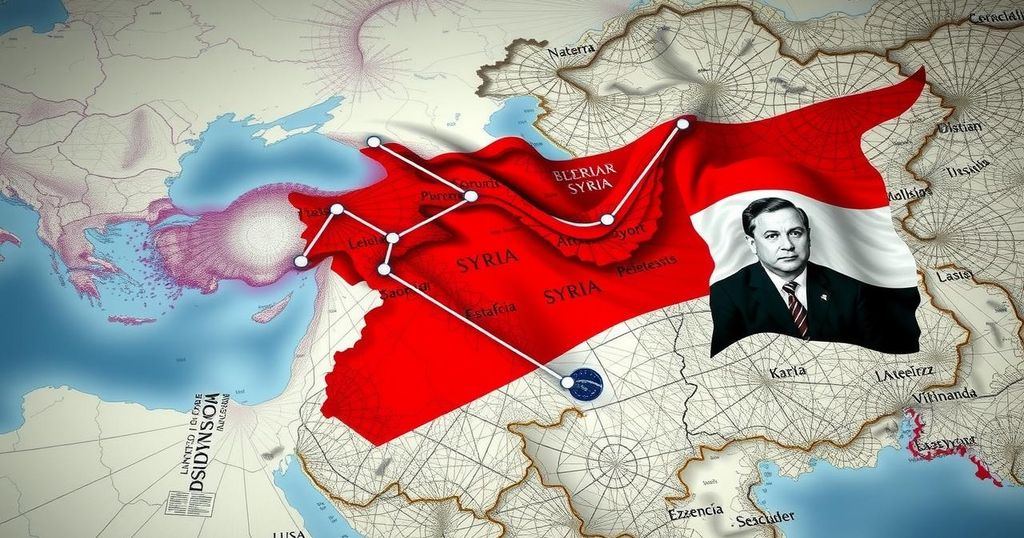The ongoing civil war in Syria, heavily influenced by external powers like Russia and Iran, faces a new phase with the potential collapse of Assad’s regime. U.S. Secretary of State Antony Blinken outlines expectations for a Syrian-led transition towards stability amid diverse sectarian challenges. The rise of the Hayat Tahrir al-Sham (HTS) group under Ahmed al-Shara presents both opportunities and risks for regional dynamics, impacting relationships with Turkey and Jordan, and posing security challenges to Israel.
Bashar al-Assad’s prolonged rule in Syria and the devastating civil war have largely resulted from the backing of Russia and Iran, particularly through Hezbollah. However, as Russia’s focus shifts to its actions in Ukraine, and Hezbollah’s attention diverts towards Israel, Syrian rebel factions have seized a momentous opportunity to challenge Assad’s regime. The potential collapse of Assad’s rule, responsible for around 620,000 deaths, raises questions about the future cohesion and stability among these disparate rebel groups.
From Washington, officials remain vigilant regarding the situation in Syria, where approximately 2,000 U.S. troops are stationed to combat ISIS threats. U.S. Secretary of State Antony Blinken clarified the expectations from the new Syrian government, emphasizing a process led by Syrians and respecting the rights of all citizens, ensuring humanitarian access, and preventing terrorist use of Syrian territory.
Despite an optimistic outlook, Syria’s intricate sectarian fabric complicates prospects for unity. Sunni Arabs form the majority, but other groups like the Alawites, Kurds, Christians, and Druze contribute to a volatile dynamic. The rebel leader Ahmed al-Shara of Hayat Tahrir al-Sham, with a controversial background linked to Al-Qaeda and ISIS, is scrutinized for his intentions of positioning himself as a moderate.
The implications of an empowered HTS extend beyond Syria, raising concerns about Turkey’s influence in the region. Turkish support for HTS could be leveraged by President Erdoğan, particularly against Kurdish forces which Turkey views as terrorist affiliates. Skirmishes are already noted between Turkish-backed factions and the U.S.-aligned Syrian Democratic Forces.
Jordan watches closely as HTS’s advancements may embolden extremist factions within its borders, potentially destabilizing its monarchy and threatening U.S. and Israeli interests. Meanwhile, Israel continues targeted airstrikes to counter prospective threats from returning radical elements seeking to exploit abandoned Syrian military sites post-Assad.
Internationally, the Syrian crisis symbolizes a significant shift in Arab politics, following the pattern of upheaval seen during the 2011 Egyptian revolution. However, unlike Egypt’s military, Syria lacks a cohesive alternative power structure poised to guide the nation.
Iran, sensing its influence waning in the region, has exhibited restraint, and Hezbollah is reportedly withdrawing forces from Syria, signifying a retreat from a protracted conflict. The recent geopolitical transformations, including shifts due to the Hamas-Israel conflict, may further alter the Arab landscape and present new strategic challenges.
In summary, developments in Syria, particularly the potential dissolution of Assad’s regime, are laden with complicated consequences not only for its citizens but also for regional actors such as Israel, Jordan, and Turkey. The future stability of Syria remains uncertain as the various interests of external powers influence the chaotic landscape of post-Assad governance.
The ongoing conflict in Syria has had a significant impact on the geopolitical landscape of the Middle East, shaping the interactions between various state and non-state actors. The involvement of external powers like Russia and Iran has bolstered Bashar al-Assad’s regime during the civil war, complicating efforts towards a peaceful resolution. Amidst shifting alliances and the attention of regional players, the potential collapse of Assad’s rule generates a tumultuous environment poised for both opportunity and uncertainty in national governance and security across Syria and its neighbors.
The future of Syria is precariously balanced on the outcomes of the ongoing struggle for power among different factions. While the potential weakening of Assad’s regime opens avenues for a new government, myriad external interests from power players like the U.S., Israel, Turkey, and Jordan complicate the scenario. As the situation evolves, careful monitoring of both local dynamics and international responses remains crucial to understanding the implications for regional stability and security.
Original Source: www.ajc.org







